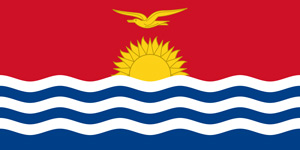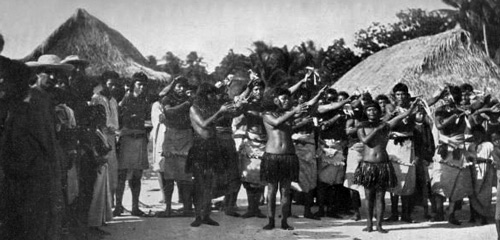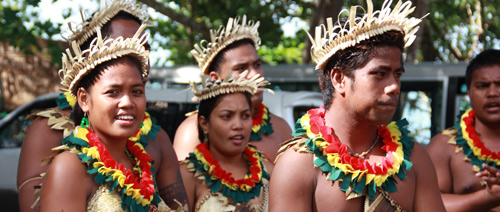Map
Flag

Quick facts
Official Name: Republic of Kiribati (pronounced Kiribas)
Indigenous Peoples: I Kiribati
Official Languages: Gilbertese, English
Political Status: Independent Nation
Capital: Tarawa
Population: 104,488 (2014 est.)
Greeting: Mauri
History and geography

Kiribati consists of about 32 atolls and one solitary island (Banaba), extending into the eastern and western hemispheres, as well as the northern and southern hemispheres. It is the only country that is situated within all four hemispheres.
The groups of islands are:
- Banaba (Ocean Island): an isolated, raised-coral island between Nauru and the Gilbert Islands;
- Gilbert Islands: 16 atolls located some 1,500 km (932 mi) north of Fiji;
- Phoenix Islands: 8 atolls and coral islands located some 1,800 km (1,118 mi) southeast of the Gilberts;
- Line Islands: 8 atolls and one reef, located about 3,300 km (2,051 mi) east of the Gilberts and Banaba.
Total land area is about 313 sq mi (811 sq km).
Banaba was once a rich source of phosphates but was mined out years ago. The rest of the land in Kiribati consists of the sand and reef rock islets of atolls or coral islands, which rise only one or two meters above sea level. Kiritimati (Christmas Island) in the Line Islands is the world’s largest atoll.
Based on a 1995 realignment of the International Date Line, the Line Islands were the first area to enter into a new year in the year 2000. For that reason, Caroline Island has been renamed Millennium Island. The majority of Kiribati, though, including the capital, is not first to enter a new year, even New Zealand has an earlier new year.
The modern history of Kiribati, known locally as “Tungaru,” began with the arrival of Micronesians between 1,500 and 2,000 years ago. Other islanders from Fiji and Tonga arrived about the 14th century and mingled with the older groups, forming the traditional i-Kiribati Micronesian society and culture. European contact began in the 16th century with the arrival of whalers, slave traders and merchants. Kiritimati was named “Christmas Island” by Captain James Cook on his third Pacific voyage on Christmas Eve in 1777. In 1820, the western group of islands was named the Gilbert Islands, after a British captain named Thomas Gilbert.
The arrival of the first Protestant missionaries in the late 1850s marked the beginning of Christianity in Kiribati. The second wave of Christian missionaries were Roman Catholic priests of the Missionaries of the Sacred Heart who landed on the island of Nononuti in 1888. Since then, Christianity has become an integral part of the Kiribati culture. The first i-Kiribati priest was ordained in 1978. He later became bishop of the Kiribati diocese.
One of the notable visitors to Kiribati was Robert Louis Stevenson (author of literary titles Treasure Island and Dr Jekyll and Mr Hyde, among others) in 1889. Setting sail for the Pacific islands in 1888, Stevenson spent time on the Kiribati atolls of Abemama and Butaritari (in the Gilbert group). Abemama Atoll was home to tyrant-chief Binoka, who was immortalized by Stevenson in his book In the South Seas.
In 1892, Kiribati became a British protectorate. In 1916 the Ellice Islands were combined with the Gilbert Islands to form the Gilbert and Ellice Islands Colony, along with the Fanning and Washington islands. Kirimiti Atoll was added in 1919, and the Phoenix Islands in 1937.
Tarawa and the some of the other islands in the Gilbert group were occupied by Japanese forces during World War II. Tarawa was the site of one of the bloodiest battles of the war between Japan and the United States. US Marines landed in 1943 trying to dislodge the Japanese defenders.
The Gilbert Islands and Ellice Islands (now Tuvalu) had separated from the group in 1975 and were granted internal self-government by Great Britain. Kiribati adopted internal self-government and a ministerial system in 1977. In July 1979, with a population of less than 60,000, Kiribati achieved independence. After long negotiations and court hearings, Banaba remained part of Kiribati. As part of the treaty formation, the United States relinquished 14 islands in the Phoenix and Line island groups to the new nation of Kiribati. Thus, using the name “Kiribati” acknowledges those islands not considered part of the Gilbert group of islands.
Kiribati is one of the poorest countries in the world due to its small land area, geographic dispersion across 5,000 km of ocean, remoteness from major markets, high vulnerability to natural forces including climate change and sea-level rise, and scarce natural resources. The economy depends on foreign assistance and revenue from fishing licenses to finance its imports and development budget.
Arts and culture

The traditional dances of Kiribati are a unique form of art and expression. The movement of the feet, hands and the whole body imitates the movement of the frigate birds while walking and flying. The costumes are made out of local materials. The frigate bird symbolizes many important things in the traditional living context of the I-Kiribati. It provides navigation to fishermen while lost at sea, provides weather information for the people and also gives a sign of peace and harmony. Smiling while dancing is generally considered vulgar within the context of Kiribati dancing. This is due to its origin of not being solely as a form of entertainment but as a form of storytelling and a display of the skill, beauty and endurance of the dancer.
Kiribati folk music is generally based on chanting or other forms of vocalizing, accompanied by body percussion. Public performances in modern Kiribati are generally performed by a seated chorus, accompanied by a guitar. However, during formal performances of the standing dance (Te Kaimatoa) or the hip dance (Te Buki), a wooden box is used as a percussion instrument. This box is constructed to give a hollow and reverberating tone when struck simultaneously by a chorus of men sitting around it. Traditional songs are often love-themed, but there are also competitive, religious, children’s, patriotic, war and wedding songs. There are also stick dances that accompany the telling of legends and semi-historical stories. These stick dances or tirere (pronounced seerere) are performed during major festivals.
Creation myth
In Pacific island legend, the origin of man is accounted for by a creation myth, with the Turtle and Spider gods creating the universe. Some myths recognize these as land gods, who were invaded and overtaken by the Eel and Stingray gods, who then created the universe. Traditional legend tells of the spirits moving from Samoa to the Gilbert Islands. The spirits became half human and half spirit, and then, a long time later, changed into human beings. Many people in Kiribati believe their ancestors to be spirits, some from Samoa, and some from the Gilberts.
